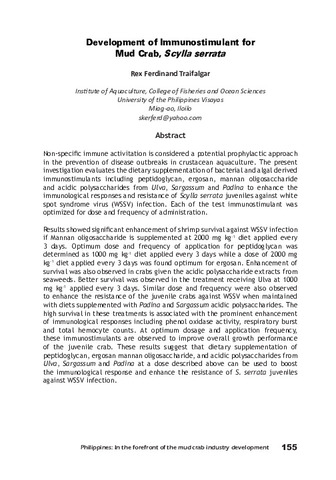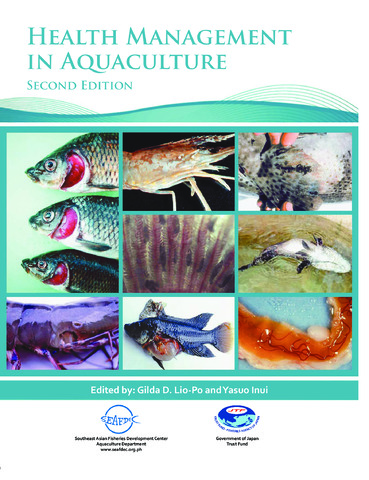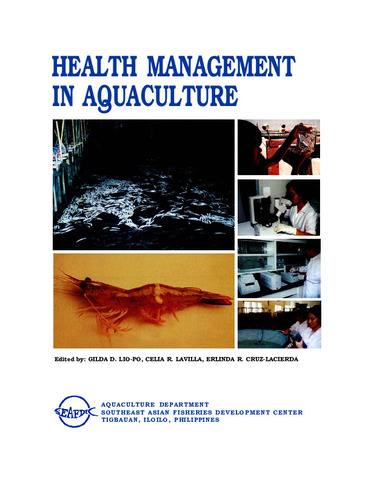Perlihatkan publikasi sederhana
Development of immunostimulant for mud crab, Scylla serrata
| dc.contributor.author | Traifalgar, Rex Ferdinand | |
| dc.contributor.editor | Quinitio, Emilia T. | |
| dc.contributor.editor | Parado-Estepa, Fe Dolores | |
| dc.contributor.editor | Coloso, Relicardo M. | |
| dc.date.accessioned | 2017-08-25T09:07:29Z | |
| dc.date.accessioned | 2017-08-25T16:34:24Z | |
| dc.date.available | 2017-08-25T09:07:29Z | |
| dc.date.available | 2017-08-25T16:34:24Z | |
| dc.date.issued | 2017 | |
| dc.identifier.citation | Traifalgar, R. F. (2017). Development of immunostimulant for mud crab, Scylla serrata. In E. T. Quinitio, F. D. Parado-Estepa, & R. M. Coloso (Eds.), Philippines : In the forefront of the mud crab industry development : proceedings of the 1st National Mud Crab Congress, 16-18 November 2015, Iloilo City, Philippines (p. 155). Tigbauan, Iloilo, Philippines: Aquaculture Department, Southeast Asian Fisheries Development Center. | en |
| dc.identifier.isbn | 9789719931072 | |
| dc.identifier.uri | http://hdl.handle.net/10862/3190 | |
| dc.description | Abstract only. | en |
| dc.description.abstract | Non-specific immune activitation is considered a potential prophylactic approach in the prevention of disease outbreaks in crustacean aquaculture. The present investigation evaluates the dietary supplementation of bacterial and algal derived immunostimulants including peptidoglycan, ergosan, mannan oligosaccharide and acidic polysaccharides from Ulva, Sargassum and Padina to enhance the immunological responses and resistance of Scylla serrata juveniles against white spot syndrome virus (WSSV) infection. Each of the test immunostimulant was optimized for dose and frequency of administration. Results showed significant enhancement of shrimp survival against WSSV infection if Mannan oligosaccharide is supplemented at 2000 mg kg-1 diet applied every 3 days. Optimum dose and frequency of application for peptidoglycan was determined as 1000 mg kg-1 diet applied every 3 days while a dose of 2000 mg kg-1 diet applied every 3 days was found optimum for ergosan. Enhancement of survival was also observed in crabs given the acidic polysaccharide extracts from seaweeds. Better survival was observed in the treatment receiving Ulva at 1000 mg kg-1 applied every 3 days. Similar dose and frequency were also observed to enhance the resistance of the juvenile crabs against WSSV when maintained with diets supplemented with Padina and Sargassum acidic polysaccharides. The high survival in these treatments is associated with the prominent enhancement of immunological responses including phenol oxidase activity, respiratory burst and total hemocyte counts. At optimum dosage and application frequency, these immunostimulants are observed to improve overall growth performance of the juvenile crab. These results suggest that dietary supplementation of peptidoglycan, ergosan mannan oligosaccharide, and acidic polysaccharides from Ulva, Sargassum and Padina at a dose described above can be used to boost the immunological response and enhance the resistance of S. serrata juveniles against WSSV infection. | en |
| dc.language.iso | en | en |
| dc.publisher | Aquaculture Department, Southeast Asian Fisheries Development Center | en |
| dc.subject | Padina | en |
| dc.subject | Sargassum | en |
| dc.subject | Philippines | en |
| dc.title | Development of immunostimulant for mud crab, Scylla serrata | en |
| dc.type | Conference paper | en |
| dc.citation.spage | 155 | |
| dc.citation.conferenceTitle | Philippines : In the forefront of the mud crab industry development : proceedings of the 1st National Mud Crab Congress, 16-18 November 2015, Iloilo City, Philippines | en |
| dc.subject.asfa | bacterial diseases | en |
| dc.subject.asfa | bioactive compounds | en |
| dc.subject.asfa | crab culture | en |
| dc.subject.asfa | diet | en |
| dc.subject.asfa | disease control | en |
| dc.subject.asfa | growth | en |
| dc.subject.asfa | immunity | en |
| dc.subject.asfa | infectious diseases | en |
| dc.subject.asfa | juveniles | en |
| dc.subject.asfa | marine crustaceans | en |
| dc.subject.asfa | disease prophylaxis | en |
| dc.subject.asfa | saccharides | en |
| dc.subject.asfa | survival | en |
| dc.subject.asfa | therapy | en |
| dc.subject.asfa | vibriosis | en |
| dc.subject.scientificName | Ulva | en |
Files in this item
Publikasi ini ada di koleksi berikut
-
Philippines : In the forefront of the mud crab industry development [44]
Proceedings of the 1st National Mud Crab Congress





